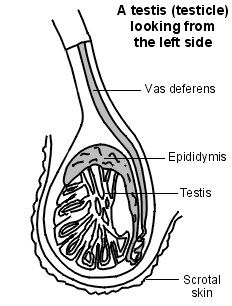
What are the testes?
The testes hang down behind the penis and make sperm. It is normal for one testes to be slightly bigger than the other, and for one to hang slightly lower than the other. The testes themselves feel like smooth, soft balls inside the baggy scrotum. At the top and to the back of each testis is the epididymis (this stores the sperm). This feels like a soft swelling attached to the testis, and can be quite tender if you press it firmly.
Leading from the epididymis is the vas deferens. You can feel each vas deferens at each side at the back and top of the scrotum. They feel like soft, narrow tubes which pass up and into the groin. (The vas deferens carries the sperm to the penis.) Some people confuse the normal epididymis or vas deferens with an abnormal lump.
What is cancer?
Cancer is a disease of the cells in the body. The body is made up from millions of tiny cells. There are many different types of cell in the body, and there are many different types of cancer which arise from different types of cell. What all types of cancer have in common is that the cancer cells are abnormal and multiply 'out of control'.
A malignant tumour is a 'lump' or 'growth' of tissue made up from cancer cells which continue to multiply. Malignant tumours invade into nearby tissues and organs which can cause damage. Malignant tumours may also spread to other parts of the body. This happens if some cells break off from the first (primary) tumour and are carried in the bloodstream or lymph channels to other parts of the body. These small groups of cells may then multiply to form 'secondary' tumours (metastases) in one or more parts of the body. These secondary tumours may then grow, invade and damage nearby tissues, and spread again.
Some cancers are more serious than others, some are more easily treated than others (particularly if diagnosed at an early stage), some have a better outlook (prognosis) than others.
So, cancer is not just one condition. In each case it is important to know exactly what type of cancer has developed, how large it has become, and whether it has spread. This will enable you to get reliable information on treatment options and outlook.
See separate leaflet called 'What are Cancer and Tumours' for further details about cancer in general.


What is testicular cancer?
Testicular cancer is a 'germ cell cancer' as the cells which become cancerous are those involved with making sperm. It is uncommon, but is the most common cancer in men aged 20-40. There are about 1400 new cases in the UK each year. It seems to be getting more common. Testicular cancers are divided into two main types (depending on the exact type of cell causing the cancer). 醫(yī).學 全在.線,提供www.med126.com
In general, all types of testicular cancer cause similar symptoms and are treated much the same.
What causes testicular cancer?
A cancerous tumour starts from one abnormal cell. The exact reason why a cell becomes cancerous is unclear. It is thought that something damages or alters certain genes in the cell. This makes the cell abnormal and multiply 'out of control'. (See separate leaflet called 'What Causes Cancer' for more details.)
In many cases testicular cancer develops for no apparent reason. However, certain 'risk factors' increase the chance that testicular cancer may develop. These include:
Vasectomy does not increase the risk of testicular cancer. (Several years ago there was a 'scare' linking vasectomy with testicular cancer. Studies have ruled out this link.)